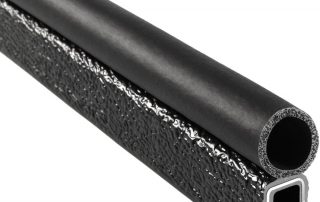Edge trim is used to protect personnel, vehicles, machinery, and equipment. Applications include vehicle doors, truck cabs, machine guards, and equipment cabinets. To help the rubber seal absorb impact, edge trim can contain either wire cores or segmented steel cores.
Edge trim can be made of EPDM, a synthetic rubber that resists moisture and withstands temperature extremes. This closed-cell rubber also provides a relatively high degree of electrical insulation. Unlike some other elastomers, EPDM edge trim exhibits superior UV resistance. This makes EPDM edge trim a good choice for mobile equipment and other outdoor applications.
PVC edge trim is often used with interior applications such as storage cabinets. Lightweight plastic with a closed-cell structure, PVC edge trim withstands the absorption of water and will not swell like wood. PVC cracks at cold temperatures, however, and may become discolored from prolonged exposure to sunlight.
Neoprene edge trim provides more limited flexibility at low temperatures but offers flame and water resistance. TPE edge trim is less likely to crack in the cold than PVC; however, the TPE trim seals are more expensive. Silicone edge trim provides low toxicity, low chemical reactivity, and thermal stability over a wide temperature range. Dust and other particles may adhere to silicone rubber, however.
Edge Trim can be reinforced with wire cores or segmented wire cores. Solid steel cores withstand impact under cold temperatures and cold weather conditions. Edge Trim with segmented steel cores may contain cold-rolled steel that provides good elongation properties.
EPDM is used for temperatures between -40 deg. C and +120 deg. C when chemical and weather resistance is vital.
PVC and Nitrile are used for oil resistance.
Silicone is used for temperatures between -40 deg. C and +180 deg C. it offers excellent weather resistance.
